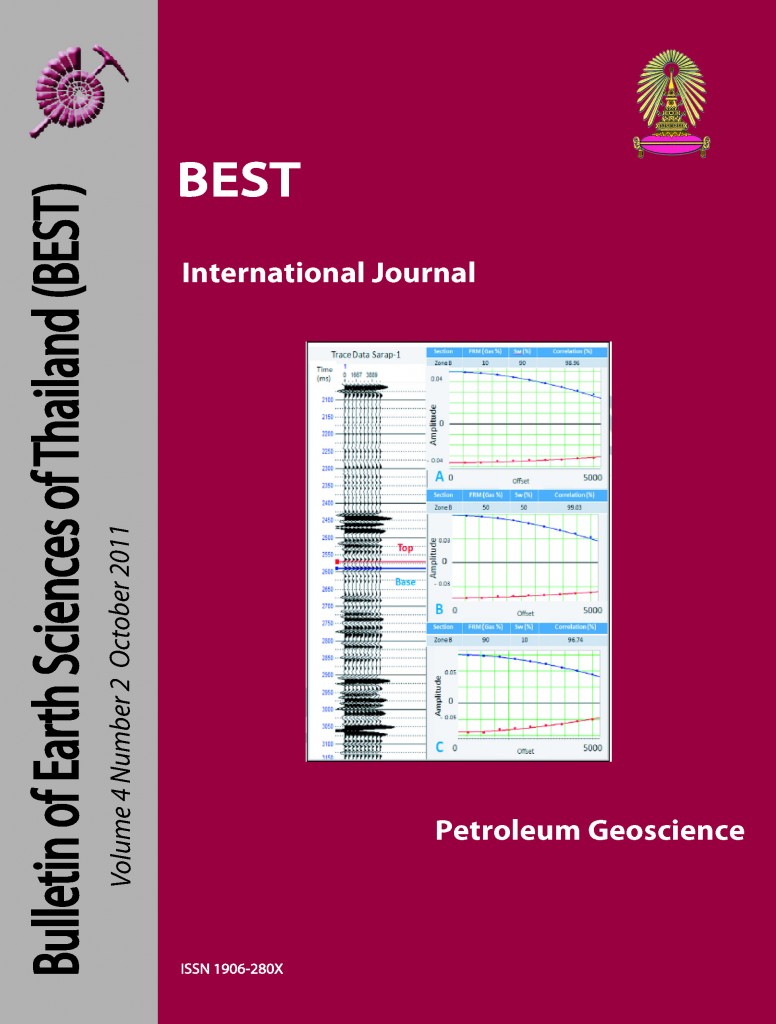Carbon Dioxide Distribution in Erawan, Platong and Pailin Fields, Gulf of Thailand
Main Article Content
Abstract
The Platong, Erawan and Pailin fields which have very good hydrocarbon potential are located in the Pattani Basin in the Gulf of Thailand. However, high carbon dioxide percentages within the producing reservoirs are the major problem for these fields production. This study aimed to identify possible sources of the carbon dioxide and to understand the distribution patterns of carbon dioxide in each field by using geochemistry for source identification and structural mapping to identify possible migration pathways. The geochemical analysis suggests that the main carbon dioxide source of the Platong, Erawan and Pailin fields comes from mineral decomposition of basement rocks. There is minor component from carboxylation of organic matter in Pailin field. Carbon dioxide migrated from source to primary reservoir by faulting. Basement penetrating faults are the major component that control vertical migration. Secondary faults provide minor lateral migration. These structures are formed above hinge zones of basement. The graben position above basement also controls the degree and continuity of gas charging. In general the carbon dioxide content increases with depth towards the source and is relatively high around the graben margins. However the charging history, stratigraphic complexity and structural styles are complex factors which affect the distribution pattern also, and produce variations from the simple model developed in this study.
Article Details

This work is licensed under a Creative Commons Attribution-NonCommercial-NoDerivatives 4.0 International License.
Copyright © 2008 Department of Geology, Faculty of Science, Chulalongkorn University. Parts of an article can be photocopied or reproduced without prior written permission from the author(s), but due acknowledgments should be stated or cited accordingly.
References
Bustin, R. M. and Chonchawalit, A., 1997. Petroleum source rock potential and evolution of Tertiary strata, Pattani Basin, Gulf of Thailand, AAPG Bulletin, v. 81, no. 12, p. 2000-2023.
Jardine, E., 1997. Dual petroleum systems governing the prolific Pattani Basin, offshore Thailand, Petroleum systems of S.E. Asia and Australasia Conference, Jakarta, May 21-23, 1997, p. 351-363.
Jenden, P.D. and Kaplan I.R., 1989. Analysis of gases in the earth’s crust, Collection of papers about the oil, gas and source rock geochemical investigations, AAPG Pacific Section, 2009.
Kornsawan, A. and Morley, C.K., 2000. The origin and evolution of complex transfer zones (graben shifts) in conjugate fault systems around the Funan Field, Pattani Basin, Gulf of Thailand. Journal of Structural Geology, v. 24, p. 435-449.
Lian, H.M. and Bradley, K., 1986. Exploration and Development of Natural
Gas, Pattani Basin, Gulf of Thailand Transactions of the Fourth CircumPacific Energy and Mineral Resources Conference, 1986.
Watcharanantakul, R. and Morley, C. K., 2001. Syn-rift and post-rift modeling of the Pattani Basin, Thailand: evidence for a ramp-flat detachment. Marine and Petroleum Geology, v.17, p. 937-958.


